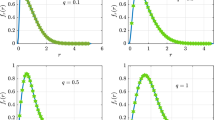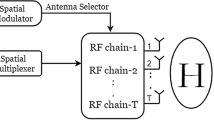Abstract
Spatial multiplexing (SMX) multiple-input multiple-output (MIMO) systems are promising candidates to enhance the achievable throughput and the overall spectral efficiency in future wireless systems. Performance studies of these systems over different channel conditions assume simplified models for the channel phase distribution. This paper highlights the impact of the channel phase distribution assumption on the performance of SMX MIMO systems. The Nakagami-m and the \(\eta -\mu\) fading channels are considered in this study. In existing literature, performance studies of SMX MIMO systems over Nakagami-m fading channel assume uniform phase distribution. Though, it has been reported recently that the Nakagami-m channel phase distribution is not uniform. In this article, we show that the assumption of the channel phase distribution has a major impact on the performance of SMX MIMO systems. The obtained results demonstrate that the performance of SMX MIMO systems significantly varies with different channel phase distributions. Furthermore, it is shown that uniform assumption of channel phase distribution is incorrect and leads to erroneous conclusions. Detailed performance analysis for more accurate channel models are provided and results are sustained through Monte-Carlo simulations.






Similar content being viewed by others
References
Wang, P., Li, Y., Song, L., & Vucetic, B. (2015). Multi-gigabit millimeter wave wireless communications for 5G: From fixed access to cellular networks. IEEE Communications Magazine, 53(1), 168–178.
Al-Dulaimi, A., Al-Rubaye, S., Ni, Q., & Sousa, E. (2015). 5G communications race: Pursuit of more capacity triggers lte in unlicensed band. IEEE Vehicular Technology Magazine, 10(1), 43–51.
Mallik, R., Singh, S., Murch, R., & Mehra, S. (2015). Signal design for multiple antenna systems with spatial multiplexing and noncoherent reception. IEEE Transactions on Communications, 63(4), 1245–1258.
Larsson, E., Edfors, O., Tufvesson, F., & Marzetta, T. (2014). Massive mimo for next generation wireless systems. IEEE Communications Magazine, 52(2), 186–195.
Ordoez, L., Palomar, D., Pages-Zamora, A., & Fonollosa, J. (2007). High-snr analytical performance of spatial multiplexing mimo systems with csi. IEEE Transactions on Signal Processing, 55(11), 5447–5463.
Lu, L., Li, G., Swindlehurst, A., Ashikhmin, A., & Zhang, R. (2014). An overview of massive mimo: Benefits and challenges. IEEE Journal of Selected Topics in Signal Processing, 8(5), 742–758.
Gao, X., Edfors, O., Rusek, F., & Tufvesson, F. (2015). Massive mimo performance evaluation based on measured propagation data. IEEE Transactions on Wireless Communications, 14(7), 3899–3911.
Hashem, T., & Islam, M. (2014). Performance analysis of mimo link under fading channels. In 2014 17th International conference on computer and information technology (ICCIT) (pp. 498–503).
Jiang, Y., & Varanasi, M. (2009). The rf-chain limited mimo system-part I: Optimum diversity-multiplexing tradeoff. IEEE Transactions on Wireless Communications, 8(10), 5238–5247.
Di Renzo, M., & Lu, W. (2015). Stochastic geometry modeling and performance evaluation of mimo cellular networks using the equivalent-in-distribution (eid)-based approach. IEEE Transactions on Communications, 63(3), 977–996.
Simon, M. K., & Alouini, M. (2005). Digital Communication over Fading Channels (2nd ed.). ser. Wiley series in telecommunications and signal processing. John Wiley & Sons, Inc., ISBN: 978-0-471-64953-3.
Di Renzo, M., & Haas, H. (2012). Bit error probability of spatial modulation (SM) MIMO over generalized fading channels. IEEE Transactions on Vehicular Technology, 61(3), 1124–1144.
Yacoub, M. (2010). Nakagami-m phase-envelope joint distribution: a new model. IEEE Transactions on Vehicular Technology, 59(3), 1552–1557.
Yacoub, M. D. (2007). The \(\eta -\mu\) distribution and the \(\kappa -\mu\) distribution. IEEE Antennas Propagation Magazine, 49(1), 68–81.
Proakis, J. G., & Salehi, M. (2008). Digital communications (5th ed.). ser. McGraw-Hill Series in Electrical and Computer Engineering, Director, S. W. (Ed.), McGraw-Hill Higher Education.
Mesleh, R., Ikki, S. S., & Aggoune, H. M. (2014). Quadrature spatial modulation-performance analysis and impact of imperfect channel knowledge. Transactions on Emerging Telecommunications Technologies, (2905), 1–9. doi:10.1002/ett.2905.
Nakagami, M. (1960). The m-distribution–A general formula of intensity distribution of rapid fading. In W. C. Hoffmann (Ed.), Statistical methods in radio wave propagation. New York: Elmsford.
Yacoub, M., Fraidenraich, G., & Santos Filho, J. (2005). Nakagami-m phase-envelope joint distribution. Electronics Letters, 41(5), 259–261.
da Costa, D. B., & Yacoub, M. D. (2007). The \(\eta -\mu\) joint phase-envelope distribution. IEEE Antennas Wireless Propagation Letters, 6, 195–198.
Turin, G. L. (1960). The characteristic function of hermitian quadratic forms in complex normal variables. Biometrika, 47(1/2), 199–201.
Abramowitz, M., & Stegun, I. A. (1972). Handbook of mathematical functions with fomulas, graphs, and mathematical tables (9th ed.). New York: Dover Publications.
Author information
Authors and Affiliations
Corresponding author
Rights and permissions
About this article
Cite this article
Mesleh, R., Badarneh, O.S., Younis, A. et al. How significant is the assumption of the uniform channel phase distribution on the performance of spatial multiplexing MIMO system?. Wireless Netw 23, 2281–2288 (2017). https://doi.org/10.1007/s11276-016-1286-z
Published:
Issue Date:
DOI: https://doi.org/10.1007/s11276-016-1286-z




